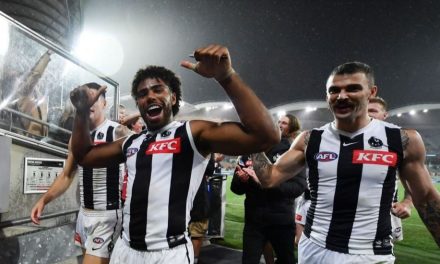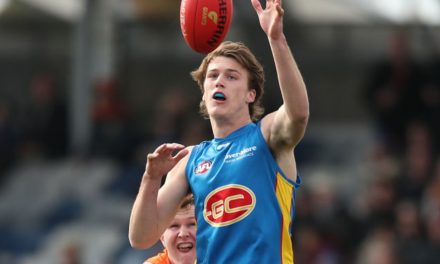Big stars, big clubs, and at last, a genuinely big game. Richmond’s Dustin Martin (left) and Collingwood’s Jordan de Goey.
Since Hawthorn’s famous upset of hot favourite Geelong in the 2008 AFL grand final, the Cats and Hawks have played each other 25 times, every clash in front of a packed MCG.
It’s been the most sustained and anticipated rivalry of the AFL era, but when the two great foes faced off again last Sunday, things were noticeably different.
For the first time, the game was parked in the early Sunday slot of a 1.10pm start, a time when many people, particularly those who enjoy a biggish Saturday night, were still digesting their brunch.
Then there was the crowd of 53,636, not shabby by any means, but still the lowest the Cats and Hawks had drawn since they met in Launceston in early 2007, before their rivalry had been established.
The other significant difference was the lack of fanfare leading up to the match. Just about any Geelong-Hawthorn game since 2008 has been accompanied by days of speculation about team selection and reminiscences about previous epic clashes. This one appeared to sneak up almost without notice.
Is the rivalry not what it was? Sure, the Hawks aren’t the powerhouse they were in winning three straight premierships between 2013-15, but it’s not like they aren’t still a pretty capable team, as their subsequent four-goal victory over the top team on the ladder proved.
I tend to think instead the comparatively low-key nature of the build-up, the scheduling and the crowd had more to do with how the game is presented to the football public now, both by the AFL itself, and through the football media.
That is, as a self-contained piece of entertainment, devoid of context, anticipation or a denouement, or in more practical terms, if it’s the final game on a Sunday, even the singing of the victorious team’s theme song, Channel 7 racing straight off to the news, Fox Footy to the “light entertainment” of “Bounce”.
In summary, there’s a lot of action. But not necessarily a lot of explanation as to what all that action actually means.
Outside finals, the biggest games of the season these days are invariably the “blockbusters”. That’s a tag which used to be applied more arbitrarily to meetings of not only big clubs, but teams in form, whose impending clash was a likely pointer to how the premiership may eventually play out.
These days, though, it’s as good as a formal status applied to either the games in the Friday night showpiece timeslot, public holidays, or for some sort of cause, like the “Big Freeze”, which is both an event game and a traditional public holiday clash between Melbourne and Collingwood.
Nothing wrong with a fundraiser for a very worthy cause, of course. But it means more often that the games over which the biggest fuss is made, and the biggest crowds are drawn, most tickets sold months in advance, aren’t necessarily the most important in the context of the season.
It means that when big moments, big surprises or just cracking games of football to be treasured happen relatively unexpectedly throughout an AFL season (and isn’t that sort of spontaneity much of what makes sport so special?) they don’t necessarily get the treatment they deserve.
A good example might be the Essendon-North Melbourne clash a couple of weeks back. Many of those who watch as much AFL football over a weekend and a season as anyone claim that this was the best game of 2019, and not just because of its dramatic conclusion with Anthony McDonald-Tipungwuti kicking the match-winning goal with only 17 seconds left on the clock.
But sandwiched between two afternoon and two Saturday evening games in the twilight slot, it was like a shooting star, something of wonder for a few precious moments but inevitably gobbled up by a succession of other games, incidents and controversies even that day, let alone by the time a whole round had been completed.
That would matter less if the bulk of the football media responded with a scale of coverage and enthusiasm proportionate to the quality and importance of the spectacle. But in case you hadn’t noticed, the media as an entity, let alone the football media, is a very different beast from what it was even a decade ago.
Resources are thinner on the ground. There’s not nearly as much flexibility at short notice in the breadth of coverage of a game, nor the importance placed upon it. That’s hardly helped, either, by the blanket of football that is strategically thrown across the entire weekend for the benefit of TV broadcasters.
And when it comes to television, almost perversely, despite there being more games shown than ever before, there’s less immediate analysis than even in the 1970s. Back then, shows like “Football Inquest” summed up the events of a Saturday’s football within an hour or two of its completion.
These days, even in an age of immediacy and saturation coverage, for that you wait until Monday evenings, a little like Australian fans of English soccer back then waited a week and a couple of days to see the “Big Match” highlights of games long decided.
Print is a different environment altogether, but there, too, the focus has turned away from the build-ups to what could be big games, and more towards a heavier diet of speculation about various players’ contractual status and potential shifts of club, or dutiful reporting of what this or that former star among the army now spread throughout all media platforms said on another media outlet.
All of which has helped give the lead-in to Friday night’s crucial MCG clash between Richmond and Collingwood an nostalgic, almost “retro” feel.
This game between the Tigers and Magpies pits a team in poor form and barely hanging on to a spot in the all-important top four, against one on a roll, attempting to grab a double chance at its opponent’s expense.
There’s two huge supporter bases ready to joust, and the extra spice of Collingwood having last September on preliminary final night denied Richmond what had appeared nearly all year an inevitable grand final berth.
This week, there actually has been a build-up to a match outside the roster of “event” games, conversations about how each side might tackle the other, who should and shouldn’t play, thoughts from the coaches on how it might pan out, and debate about the consequences of victory or defeat for either team.
Of course we’ve still had the usual plethora of contract stories and, with three vacant coaching positions to be filled, plenty of on-going speculation about which candidates will fill them.
But, unusually of late, this week it hasn’t felt like the actual games themselves are being played out in some sort of vacuum. We know we’ve got a big game on our hands. One with very obvious ramifications for the destination of this year’s premiership.
And in the end, whether the game is marketed like an alternative form of entertainment or reported as an industry, that’s what it’s all really about, isn’t it?
*This article first appeared at INKL.











